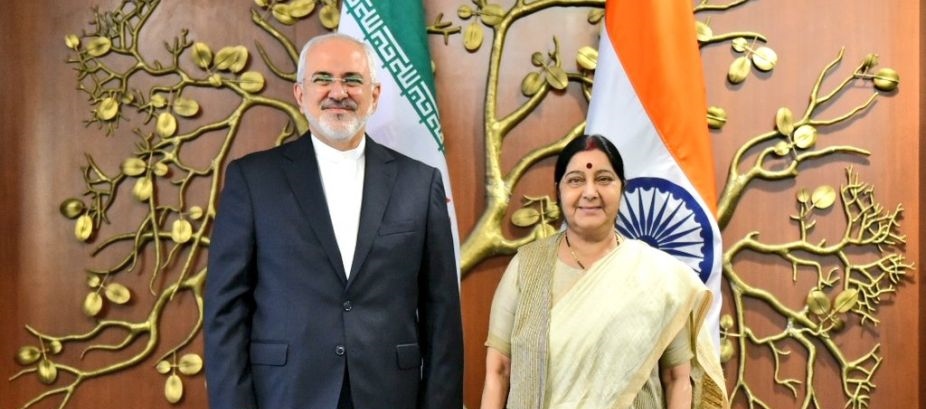India to continue trade with Iran
May 29, 2018 | Expert Insights

Indian Foreign Minister Sushma Swaraj has said that New Delhi’s foreign policy is not shaped by pressure from foreign governments. She stated that India will continue to trade with Iran as it follows UN and not US sanctions.
India is also in danger of facing repercussions for continuing defense trade with Russia despite US sanctions.
Background
India and Iran have long standing historical and cultural ties. India’s first Prime Minister Jawaharlal Nehru said, "Few people have been more closely related in origin and throughout history than the people of India and the people of Iran." Trade between the two regions dates back to India’s Indus Valley Civilization, which was a contemporary of the Mesopotamian civilization.
India and Iran established modern diplomatic relations in 1950. During the Cold War, the two nations kept a studied distance due to India’s participation in the Non-Alignment Movement and Iran’s ties to the US. After the 1979 Iranian revolution, Iran’s relationship with Washington suffered, and ties between India and Iran strengthened momentarily. However, Iran's continued support for Pakistan and India's close relations with Iraq during the Iran–Iraq War impeded further development of Indo–Iranian ties. Iran is home to 7 million expatriate Indians.
Iran is one of the largest suppliers of oil to India. In 2011, the US$12 billion annual oil trade between India and Iran was impacted by extensive economic sanctions against Iran, forcing the Indian oil ministry to pay off the debt through a banking system through Turkey. The sanctions were a result of Iran’s nuclear programme, which has been a source of concern for the international community.
Iran nuclear deal, also known as the JCPOA (Joint Comprehensive Plan of Action), was signed by Iran and major powers UK, China, France, Germany, Russia, and the US (the P5+1) in 2015. The deal was a result of almost a decade of sanctions due to Iran’s non-compliance with the Nuclear Non-Proliferation Treaty. Under the JCPOA, Iran would limit its nuclear ambitions in return for relief from a number of sanctions. It was declared that Iran had complied with the terms of the provisional agreement and sanctions were lifted in 2016. Read more on the nuclear deal here.
On May 8th, 2018, President Trump announced that the US would be withdrawing from the “decaying and rotten” nuclear deal. This move was taken against the advice of allies such as France and Germany, whose leaders lobbied for the Trump administration to preserve the deal. All other major signatories of the JCPOA (Russia, China, UK, France, Germany) have reiterated their commitment for the deal.
Analysis
Indian foreign minister Sushma Swaraj met her Iranian counterpart Javad Zarif in New Delhi on Monday. Zarif has made diplomatic visits to a number of countries to garner support following US withdrawal of the JCPOA. A government statement noted that Zarif had briefed India on “the discussions that Iran has undertaken with parties to the Joint Comprehensive Plan of Action” following US withdrawal.
Zarif tweeted, “Fruitful visit to #India, building on achievements of President Rouhani's state visit in Feb. Productive meetings on energy, banking, transportation and commerce. Excellent substantive concluding meeting with my counterpart and delegations. Resolved to expand ties in all fields.”
Officials have now indicated that India will not follow the US in re-imposing sanctions on Iran. “India follows only U.N. sanctions, and not unilateral sanctions by any country,” Swaraj said at a recent news conference in New Delhi. "We don't make our foreign policy under pressure from other countries," she added. Swaraj noted that India had continued to do business with Iran despite US sanctions in the past as well. American National Security Adviser John Bolton has warned that countries that “continue to deal with Iran could face sanctions”.
In February this year, India announced that it would be investing in Iran through the Rupee and strengthening its ties with the nation. India is also developing Iran’s Chabahar Port, provides India with strategic access to Afghanistan, and easier import of crude oil. During President Rouhani’s visit to India earlier this year, both sides signed nine agreements. In April, it was reported that Indian state refiners planned to almost double oil imports from Iran in 2018-19 due to incentives offered by Tehran. The recent geopolitical shift has already resulted in a rise in fuel prices. Read more here.
India has also recently finalized a deal with Moscow worth $5 billion for five S-400 long-range surface-to-air missile systems. India receives approximately 62% of its military hardware from Russia. This has left India vulnerable to US measures such as CAATSA (Countering America’s Adversaries through Sanctions Act), according to which any country trading with Russia’s defense and intelligence sectors could also face sanctions. However, Indian officials have said, “We are not going to allow our defense requirements to be dictated by any other country. Whatever is in India’s interests in terms of procuring equipment for national security is what will determine how we act with various countries.” Indian Prime Minister Modi recently met Russian President Vladimir Putin for informal talks, in which the two leaders reaffirmed their strategic and defence partnership.
Assessment
Our assessment is that Iran is India’s third largest oil supplier and would likely be affected by the sanctions if it adopts them. We believe that the US’s decision to re-impose sanctions on Iran might impact India’s oil imports if the US compels the EU and other nations to follow the measures. Washington's decision on whether to sanction India's defence purchases from Russia, under CAATSA (Countering America’s Adversaries through Sanctions Act), could indicate whether India is at risk for continuing to trade with Iran.








Comments